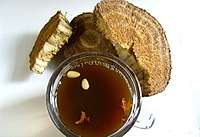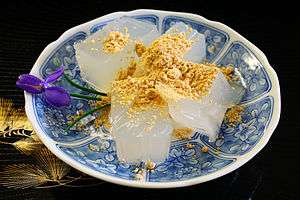Pueraria montana var. lobata
Pueraria montana var. lobata, the East Asian arrowroot,[2] is a perennial plant in the family Fabaceae.
| East Asian arrowroot(Chinese : 葛根) | |
|---|---|
 | |
| Scientific classification | |
| Kingdom: | |
| (unranked): | |
| (unranked): | |
| (unranked): | |
| Order: | |
| Family: | |
| Subfamily: | |
| Tribe: | |
| Genus: | |
| Species: | |
| Variety: | P. montana var. lobata |
| Trinomial name | |
| Pueraria montana var. lobata (Willd.) Maesen & S. M. Almeida ex Sanjappa & Predeep | |
| Synonyms[1] | |
| |
Distribution
The plant is native to East Asia (China, Taiwan, Japan, Korea), North Asia (Russian Far East), Southeast Asia (Indonesia, Malaysia, the Philippines, Thailand and Vietnam), and the Pacific (New Caledonia, Papua New Guinea, Solomon Islands, and Vanuatu).[3]
Use
The starch powder made from the East Asian arrowroot is called kudzu powder. Kudzu powder is used to make arrowroot tea in tradinal medicines of China, Japan and Korea[4] (in Korea the root unprepared is also used).
 East Asian arrowroot.
East Asian arrowroot. Arrowroot tea.
Arrowroot tea. Kuzumochi made using kudzu powder.
Kuzumochi made using kudzu powder.
gollark: 2022.
gollark: oh bees this fat32 to regex thing is very æ.
gollark: Lyric is very popular¡¡¡¡¡¡¡¡¡¡¡¡¡¡¡¡¡¡¡¡¡
gollark: Wow, another person!
gollark: ++delete <@!308493066879369219>
References
- "Pueraria montana var. lobata (Willd.) Sanjappa & Pradeep". International Legume Database & Information Service (ILDIS). Retrieved 23 February 2018 – via The Plant List.
- Korea National Arboretum (2015). English Names for Korean Native Plants (PDF). Pocheon: Korea Forest Service. p. 596. ISBN 978-89-97450-98-5. Retrieved 23 February 2018.
- "Pueraria montana var. lobata". Germplasm Resources Information Network (GRIN). Agricultural Research Service (ARS), United States Department of Agriculture (USDA). Retrieved 23 February 2018.
- Chun, Hui-jung (2004). Yoon, Ho-mi (ed.). Korean Food Guide 800. Seoul: The Korea Foundation. p. 208. ISBN 978-89-89782-10-0. Retrieved 23 February 2018 – via issuu.
This article is issued from Wikipedia. The text is licensed under Creative Commons - Attribution - Sharealike. Additional terms may apply for the media files.